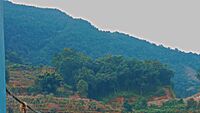Bhalam
Federal Territory of Bhalam | |
|---|---|
| Anthem: "Peace is our goal" Royal Anthem: " O! Our Great Ruler" | |
| Sovereign State | |
| Capital and largest settlement | Rayalechaur |
| Official languages | Nepali |
| Recognised national languages | English |
| Scheduled recognized languages | |
| Ethnic groups (2025) | |
| Religion (2023) |
|
| Demonym(s) | Bhalamian |
| Government | Devolved locally governing dependency under semi-constitutional monarchy |
• Monarch | Varuna Sriraya |
• Governor | Narendra Singh Chhetri |
| Prakash Pokhrel | |
| Area | |
• Total | 4,000 km2 (1,500 sq mi) |
| Population | |
• 2024 estimate | 20 |
| Currency | Bhalamian rupee (Rs, रू) |
| Time zone | UTC+05:45 |
| Date format | mm/dd/yyyy |
| Driving side | right |
| Calling code | +11 |
| Internet TLD | .bh |
Bhalam (Nepali: भलाम) is a self-proclaimed federal territory, officially the Federal Territory of Bbalam more commonly known as micronation is a micronational Territory in South Asia. Bhalam is a Federal Territory of the Vishwamitra, with the Governer having the federal power. The capital and the largest city is Rayalechaur, which is the national administrative capital of the nation. Bhalam is located in a beautiful city of lakes of Nepal named Pokhara. The main administrative region of Bhalam is its seven states.
Bhalam was established on 6 December 2023 as a Federal Hindu semi-costitutional monarchy by Sulav Chhetri he was the first monarch of the official Kingdom of Bhalam.
Later the Kingdom of Bhalam became member of the South Asian Association of Micronational Cooperation but there was some dispute in Bhalam not getting full member so Bhalam formed a new alliance with the South Asian Micronation Alliance - SAMA and the Bhalam became the Protectorate of the Laskaridian Commonwealth Association but later the Kingdom of Bhalam became the official territory of the official state of Vishwamitra leaving the Commonwealth.
Etymology
In Nepali, "Bhalam" is commonly used to refer to a tiger. The term is derived from the Sanskrit word "Vyāghra," which also means tiger. It's worth noting that language and word usage can evolve, and meanings may vary in different contexts or regions.
History
The history of Bhalam dates back to 6 December 2023 when the current monarch of Bhalam Sulav Chhetri established the official Kingdom of Bhalam with the vision of doing something new and do something and progress on the micronational community.
Protectorate of Laskaridian Commonwealth Association
On 16 January 2024 the official Kingdom of Bhalam formed alliance and became a protectorate of the Laskaridian Commonwealth Association by signing a Document of Integration between the Commonwealth and Kingdom of Bhalam and it was the first ever alliance of Bhalam. But later the Kingdom of Bhalam left the alliance.
Federal Territory of Bhalam
Later of leaving it's first alliance the Kingdom of Bhalam announced it's Annexation becoming a Federal territory of Vishwamitra and the price of Bhalam Annexation towards Vishwamitra is going on and then announcement of this Annexation was announced by His Highness and Royal Majesty Sulav Chhetri. The act named Bhalam Federal Territory Act is passed on Lok Sabha Parliament of Vishwamitra and Bhalam is officially going to be territory of Vishwamitra on 25 January 2024 on an auspicious day.
Free State of Bhalam
After Chhetri made the announcement that the Kingdom of Bhalam would be annexed by Vishwamitra, a decision voted on by the citizens of the capital, the citizens of the overseas territories, who were not informed of this vote, were angered. They were angered at the fact that their king had chosen to abandon them. And so began the Bhalam Civil War, and the citizens of the overseas territories formed the Free State of Bhalam. The Free State of Bhalam is still in operation, led by King Raptor and King Reinhard
Government and politics
Executive
Government
The administration of the overseas territory is vested upon an officer of His Majesty’s Public Services as prescribed under clause 3(iii) of Article 54 - Public Services of the Constitution of Vishwamitra. The officer of the public services is (if need be) discharge the functions as vice-regal representative of the Crown of Vishwamitra to the people and the territory. The officer is known as the “Governer of the Federal Territory of Bhalam” who is appointed at the pleasure of the Rashtradhyaksh in their capacity as Sovereign of the Federal Territories in consultation with the Minister of External Affairs of the Government of Vishwamitra. The governer is be responsible for the defence, internal affairs, finance, expenditure, emergency, disaster management, transport, business, commerce and other affairs related to the day-to-day administration of the territory. The governer, in consultation with the Sovereign and Minister of External Affairs, may appoint a Chief Minister and, the CM forms a cabinet under the approval of the governer who workspn other officials under His Majesty’s Public Services for the maintenance of the affairs of the state. Sulav Chhetri is the current and incumbent Governer of Bhalam.
Cabinet
The Chief Minister is the head of government who is appointed by the Governor and shall remain in office for a tenure concurrent with the parliament. The chief minister shall be the head of the council of ministers and the Governer shall appoint a council of ministers at the advice of the prime minister as specified under The cabinet shall be composed of the prime minister, deputy chief minister (s), senior minister and cabinet ministers which shall not exceed more than eight at a time and an supernumery ministers of state who shall be junior ministers in the cabinet.
Ministries
The current ministries of the government of Bhalam include:
- Office of the Chief Minister: responsible for handling various affairs on behalf of the chief minister.
- Ministry of Home Affairs: Responsible for handling domestic security, law enforcement, and governance matters within the country.
- Ministry of Culture and Heritage: Oversees the preservation, promotion, and development of the nation's cultural heritage, arts, and traditions.
- Ministry of Innovation and Technology: Focused on driving technological advancements, fostering innovation, and promoting digital transformation across various sectors.
- Ministry of Justice and Law: Ensures the administration of justice, upholds the rule of law, and oversees legal matters, including legislation and the judiciary system.
- Ministry of Artificial Intelligence: Leads initiatives related to the development, regulation, and ethical use of artificial intelligence technologies within the country.
- Ministry of Cyber Security: Responsible for safeguarding national cyber infrastructure, combating cyber threats, and promoting cybersecurity awareness and readiness.
- Ministry of Ethics and Integrity: Upholds ethical standards in governance, ensures transparency, accountability, and integrity in public institutions and policies.
Legislature
Bhalam's legislative branch is embodied by the Rastriya Sabha. Comprising members appointed by the King, and through elections the Parliament holds a pivotal position in the governance structure. It serves as the primary legislative body, contributing to the formulation of federal laws and policies.
The Parliament's role extends beyond a mere advisory capacity, as it actively participates in shaping the legislative landscape, reflecting the dynamic interplay between traditional governance structures and contemporary political mechanisms in Bhalam.
Political Parties
As of 16 January 2024, there was 1 political party in Bhalam. This is the Bhalamian National Party which "seeks to do anything to better Bhalam" (A quote by Party Leader Benjamin Levinson). The party was shut down on 17 January 2024 after the King decided to make Bhalam a Territory of Vishwamitra.
| Name | Party Leader | Spectrum | Ideologies | Rastriya Sabha | Cabinet | |
|---|---|---|---|---|---|---|
| Bhalamian National Party | BNP | Benjamin Levinson | 0 / 15
| |||
Administrative divisions
The Kingdom of Bhalam is divided into 7 Royal States, each governed by a Mulkaji or Kaji (Nepali: मुलकाजि, romanized: Mūlkājī, lit. 'prince'), known as the State Ruler, to differentiate them from the Rulers of States.
These are:
The precedence of the King and their consort, the rulers of the states is provided which mentions that the each ruler shall precedence over the others in their respective states and the precedence at the federal level shall be determined on the basis of their accession to the throne.
Each of the states have their own capital city which is administered by a mayor appointed by the Mulkajis in consultation with the federal Ministry of Local Administration. The mayors are responsible for the affairs of the cities. Rayalechaur, until the parliament determines otherwise, shall be the federal capital and it shall be the King who shall be responsible for formulating laws and administration of the capital. All the states and their capitals including the federal capital territory form the National Territorial Region (NTR) which is the principal territorial region of the nation.
Law and order
The Supreme Court of Bhalam is the main judiciary of the Bhalam. The Chief Justice of the Bhalam is the Chief judge of the Supreme Court and the cases in the Supreme Court are filled and discussed in Discord server.
Military
The Vishwamitran Armed Force is the land warfare force of Bhalam which is headed by the Chief of the Armed Force who is the professional head of the Armed forces. The Armed Forces has its three branches Royal Army, Royal Navy and the Royal Air Force.
Following the Armed forces, the Armed force has been tasked to formally safeguard and defend the sovereignty and integrity of the nation and her territories. The Administrators of the all forces are tasked with the power to maintain a internal defence force for the security and defence of the nation.
National symbols
The national symbols of Bhalam are things which are emblematic, representative or otherwise characteristic of Bhalam or Bhalamian culture. Some are established, official symbols, including the flag of Bhalam, and governmentally-named symbols, such as the national flower and animal. Other symbols may not hold any form official status, for one reason or another, but are likewise recognised at a national or even intermicronational level. The flag of Bhalam was adopted on 6 December 2023.
List of national and official symbols of Bhalam
| Symbol | Name | Image |
|---|---|---|
| National Flag | National flag of Bhalam | 
|
| National Coat of Arms | Coat of arms of Bhalam | File:Coat of arms of Bhalam.png |
| National motto | हिमालये सौहार्दः एकता, स्वतन्त्रता, प्रगतिः Harmony in Himalaya: Unity, Liberty, Progress |
File:Coat of arms of Bhalam.png |
| National anthem | सयौँ थुँगा फूलका ("Sayaun Thunga Phulka") | |
| National colours | Crimson and Blue | |
| National animal | Nepalese cow | 
|
| National flower | Nepalese rose | 
|
| National bird | Nepalese peacock | 
|
| National sport | Football | 
|
| Official language | Nepali English |
नेपाली
English |
| National calendar | Nepalese calendar | 
|
Geography and Climate


Bhalam's lands, located in the National Territorial Region, are enclaved in the city of Pokhara. Surrounded by the mighty Kahun and Armala Hills, the nation enjoys a wide range of flora and fauna. Most lands lie in the hills with wide variety of trees, plants and shrubs. The nation lies in the coordinates of 28.26°N and 84.01°E. Bhalam spans over the time zone of UTC+5:45 which is also termed as the Nepalese Standard Time. The topography of Bhalam is diverse and comprises of hills, mountains and plains.
Economy
Bhalam's economic landscape is marked by it's main economy source Agriculture. While specifics on the micronation's currency are covered in a separate article, an overview of fiscal information provides insights into the economic vitality of Bhalam.
Culture
The culture of Bhalam is highly influenced from Nepalese culture which is based on the heritage of social norms, ethical values, traditional customs, etc. that originated in or are associated with the Nepalese subcontinent. The State has a wide range of diverse languages, art, music, dance, cuisine, costumes which illustrates our unity in diversity.
Architecture
The architecture in Bhalam is highly influenced from the Modern and old type, which is the most followed architecture.
The houses constructed using this style are generally termed as Modern old houses, consisting usually one or more storeys. The houses are built to be earthquake proof, and are made from materials ranging from wood and soil to steel and concrete.
Media in Bhalam
The Bhalam Telivision is one of the principal sources of media in the nation, which is the only and official national newspaper of the nation run by the Ministry of Information and Broadcasting. Apart from the official newspaper, the nation has a media presence over Discord and other social media platforms.
Holidays
Public holidays in Bhalam are regulated at both federal and state levels, mainly based on a list of federal holidays observed nationwide and in the overseas territories plus a few additional holidays observed by each individual states and in the crown dependencies. The public holidays are a mix of secular holidays celebrating the nation and its history, and selected traditional holidays of the various ethnic and religious groups that make up the country.
Public holidays are determined at the beginning of a new year as per the Nepalese calendar by the Ministry of Home Affairs with approval from the King. State holidays, those celebrated in particular states, excluding the federal ones are determined by their respective Mulkajis while the Administrators of the overseas territories have the power to legislate and decree holidays to be observed in the respective territories.
The national holidays are celebrated throughout the nation with a closure of all offices of the government excluding those of emergency affairs, while the restricted or religious holidays are observed throughout the nation with an exception to the overseas territories. The closure of offices are decided by the respective departmental heads. In addition to the national and restricted holidays, each state may issue a number of state public holidays to be observed in the state. In every state, the official birthday of the state ruler is celebrated as a public holiday.

